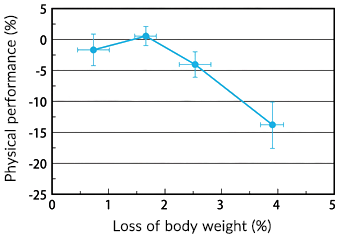When the body lacks water
Physical performance begins to decline when there is just a 2% loss of body fluid
Decline in physical performance due to dehydration

When the body is hot, blood vessels in the skin dilate to increase blood flow and allow perspiration in order to regulate the temperature. However, when we sweat a lot, we lose body fluid. When the level of body fluid falls, body temperature rises, and we face the risk of overheating.
When you lose body fluid equivalent to just 2% of your body weight, you feel thirsty and your body's ability to perform starts to fall. When you lose 3%, you get very thirsty, and experience symptoms such as feeling faint and suffering a loss of appetite. When you lose 4% to 5% of your body weight, you experience dehydration symptoms such as fatigue, headaches and dizziness. Finally, if you lose 10% or more of your body weight, there is a risk of death.
Dehydration and signs or symptoms
| Moisture reduction rate (% of body weight) |
The main symptoms of dehydration |
|---|---|
| 2% | Thirst |
| 3% | Burning thirst, absent-mindedness, loss of appetite |
| 4% | Flushing of the skin, irritability, rise in body temperature, exhaustion, decrease of urine volume but increase in its concentration |
| 5% | Headache, feeling feverish |
| 8-10% | Swaying, convulsions |
| over 20% | Anuria, death |
The following reference was provided by Takeshi Morimoto:
Nakano, S. Sports medicine science, Chapter 2, Function of body fluids and blood, (1999), p. 40. Partially modified and with a reference to Adolph EF & Associates, Physiology of man in the desert. Hafner Publishing Company, New York,(1947), p. 191.









